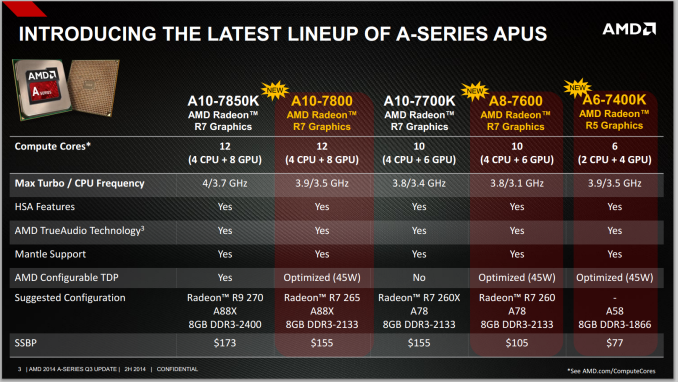AMD A10-7800 Review: Testing the A10 65W Kaveri
by Ian Cutress on July 31, 2014 8:00 AM ESTConclusions
When AMD launched their 95W Kaveri APUs and we had the opportunity to test the top A10 model, it offered some of the best integrated graphics performance for a desktop we had seen. The fact that the die is partitioned such that more than 50% of it is for the graphics, along with expanding HSA and OpenCL support, means that for applications that can be computationally enhanced by integrated graphics, AMD has the edge for the single chip solution.
In our testing, because the A10-7800 shares the same processor graphics configuration and speed as the A10-7850K, results were fairly similar despite a +100 MHz advantage to the A10-7850K. This means that, at stock, AMD is offering a similar CPU for $18 less.
If we remove the price from the equation, the biggest contender for the title of ‘best processor graphics’ is Intel’s Iris Pro. The upside of AMD’s Kaveri at the minute is not only the price, but also the form factor – Iris Pro is only available as a soldered on (BGA) CPU at this point in time whereas Kaveri is in both soldered and socketed form. Also, Iris Pro relies on an extra L4 cache, which adds size to the CPU package as well as cost and power consumption. News from Intel might change that with Broadwell, as back in May an announcement regarding a socketed, overclockable Iris Pro CPU would be coming to market. We have not the slightest clue when AMD will have this competition, but it looks good for AMD given that recent reports suggest that Broadwell for the desktop may be delayed beyond the expected launch of 14nm Core-M in Q1 2015.
In that respect, it may give AMD some time to prepare for their new 64-bit x86 architecture, or give AMD another chance to leap forward in with their Carrizo APUs (still based on modules and GCN) if they are launched in 2015.
Back to the A10-7800 reviewed today, and as it stands it is the most cost effective processor graphics solution available. Here is all the speed of the A10-7850K for $18 cheaper, and more performance than the A8-7600. The 45W configurable TDP makes it even more enticing as a lower power consumption part.
The only issue users might come across is the speed and feel when running single threaded tasks that do not utilise OpenCL or HSA – our web benchmarks put the AMD APUs behind many of our 55W Intel samples for the last couple of generations. But for anything that uses OpenCL as an accelerant, such as the software on which PCMark8 is based or anything compute, AMD comes out on top.











147 Comments
View All Comments
DigitalFreak - Thursday, July 31, 2014 - link
I'll take Conspiracy Theories for $100, Alex.Essence_of_War - Thursday, July 31, 2014 - link
Really?Here's the big haswell review:
http://www.anandtech.com/print/7003/the-haswell-re...
Here's the first Kaveri review:
http://www.anandtech.com/print/7677/amd-kaveri-rev...
Here's the Devil's Canyon review:
http://www.anandtech.com/print/8227/devils-canyon-...
There were platform power benches in all of them. Haswell-big has idle/load for a smattering of i5's/i7's, Devil's Canyon had an OC overview of system power consumption. Same with Kaveri.
DanNeely - Thursday, July 31, 2014 - link
Could you add a few low/mid end discrete GPUs that fall into the same performance bucket as Kaveri's IGP for comparison purposes?jaydee - Thursday, July 31, 2014 - link
The A10-7800 65W looks like a winner in it's market (budget gaming). Unfortunately, that's not a very large market, and if you're looking to upgrade the CPU down the road, you are quite limited.On a side note, it seems odd that 1280x1024 was chosen as the resolution for the gaming benchmarks. It's been probably a decade since the 5:4 aspect ratio monitors have been sold in the mainstream. 1440x900 or 1600x900 would make more sense, with similar total number of pixels.
Essence_of_War - Thursday, July 31, 2014 - link
This!I'd like to see a move to 1280x720 or 1600x900 for these sort of low-end graphics parts. Most living room TV's are 1920x1080, but depending on your set-up 1280x720 or 1600x900 might still look pretty good.
jabber - Thursday, July 31, 2014 - link
I would have thought 1366x768 should be the minimum benchmark size nowadays.All the others are quite custom and the average Joe won't be using them.
DanNeely - Thursday, July 31, 2014 - link
1600x900 is the current mid level gfx setting for mobile reviews; 1366x786 is the low end level. don't know why it couldn't be added to IGP benching too. The next time the IGP benchmark process is updated either of them would make more sense as a target. 1600x900 is closer in terms of pixel count; but 1366x768 is probably a more realistic option for most IGP gaming if only a single resolution is tested, since only the highest end IGPs can get FPSes high enough to play at anything higher.Essence_of_War - Thursday, July 31, 2014 - link
1280x720 is a standard resolution for TVs. For a light gaming HTPC type load, I think that's pretty reasonable to test.Guspaz - Thursday, July 31, 2014 - link
Umm, NewEgg has 146 different monitors with 1280x1024 resolution available. They're definitely still extremely mainstream, and there are only two resolutions that they have more selections for, 1920x1080 and 2560x1440.SparklesP - Thursday, July 31, 2014 - link
Still available if you're looking to buy an older budget monitor or are in the market for refurbished, but they are basically only being made to wholesale to cheap businesses these days.